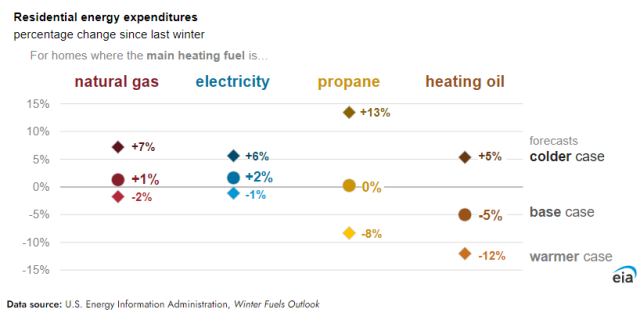The U.S. Energy Information Administration (EIA) predicts that the majority of U.S. households will spend about the same amount on heating this winter as they did last year, according to its 2024 Winter Fuels Outlook released in October.
However, Midwestern households heated by natural gas may face an 11 percent increase in costs. EIA attributes this to a forecast of colder weather, which could drive up energy consumption.
Despite the colder weather outlook, energy prices are expected to remain stable or slightly lower than last winter. EIA Administrator Joe DeCarolis highlighted the uncertainties in the forecast, especially regarding weather and commodity prices.
The report projects the following changes in heating costs compared to last year: a 1 percent increase for homes using natural gas, a 5 percent decrease for homes using heating oil, a 2 percent increase for homes using electricity, and minimal changes for homes using propane.
The Winter Fuels Outlook accompanies EIA’s Short-Term Energy Outlook (STEO), which will be updated monthly through February. This year’s forecast marks the first time EIA differentiates between heating fuels used for space heating and other purposes.
EIA forecasts lower oil prices than previously expected, with Brent crude oil averaging around $76 per barrel in the fourth quarter of 2024. U.S. oil production is expected to reach a record high of 13.5 million barrels per day by 2025.
Additionally, EIA expects a 2 percent rise in U.S. electricity consumption this year and in 2025, driven by growing demand from industries such as battery and semiconductor manufacturing, as well as data centers.
Natural Gas: Regional Variations
While natural gas prices are expected to drop overall, regional differences in expenditures will vary. Homes in the West are forecasted to see a 6 percent reduction in their natural gas bills, while those in the Midwest will face an 11 percent increase due to higher consumption. On average, households that rely on natural gas for heating (about 45 percent of U.S. homes) are expected to consume 5 percent more gas this winter compared to last year. Despite the increase in usage, the average price per household is expected to be 4 percent lower, with winter bills projected to remain around $600.
Heating Oil
For the 4 percent of U.S. households that use heating oil, mainly concentrated in the Northeast, expenditures are predicted to drop by 5 percent. The mild winter of last year contributed to a reduction in both consumption and prices for heating oil.
Propane
In the Midwest, homes using propane for heating can expect a 2 percent increase in spending due to an 11 percent rise in consumption, following a return to more typical winter temperatures. This region is expected to experience the largest increase in propane-related costs.
Electricity
Households that rely on electricity for heating will see a 2 percent rise in their winter bills, driven by slightly higher expected electricity consumption. However, price changes may vary by region, with some seeing increases and others potentially benefiting from slightly lower prices.
In summary, while the U.S. is set for lower natural gas prices, regional differences will impact how much consumers spend this winter, with Midwest homes facing higher costs due to increased consumption.
Baburajan Kizhakedath

